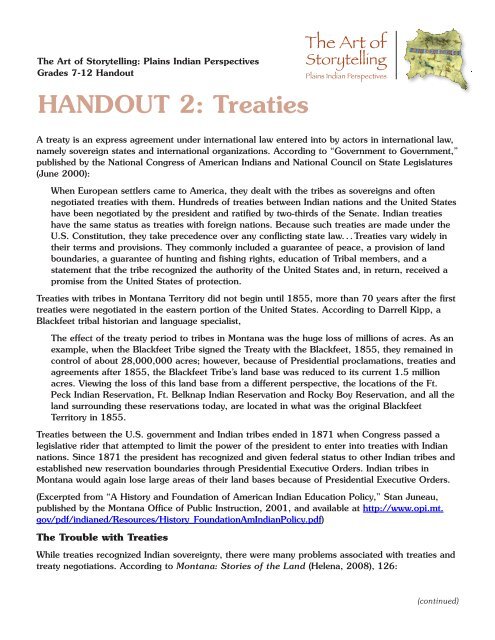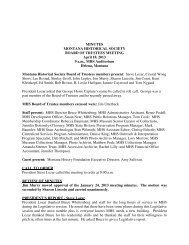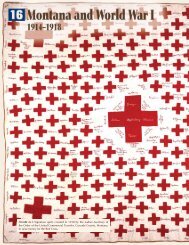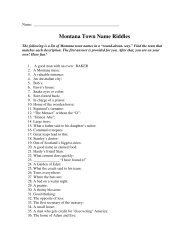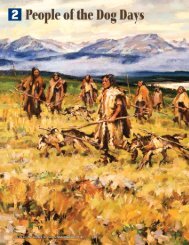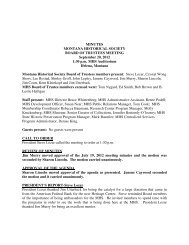Grades 7–12 - Montana Historical Society
Grades 7–12 - Montana Historical Society
Grades 7–12 - Montana Historical Society
Create successful ePaper yourself
Turn your PDF publications into a flip-book with our unique Google optimized e-Paper software.
The Art of Storytelling: Plains Indian Perspectives<br />
<strong>Grades</strong> 7-12 Handout<br />
HAndouT 2: Treaties<br />
A treaty is an express agreement under international law entered into by actors in international law,<br />
namely sovereign states and international organizations. According to “Government to Government,”<br />
published by the National Congress of American Indians and National Council on State Legislatures<br />
(June 2000):<br />
When European settlers came to America, they dealt with the tribes as sovereigns and often<br />
negotiated treaties with them. Hundreds of treaties between Indian nations and the United States<br />
have been negotiated by the president and ratified by two-thirds of the Senate. Indian treaties<br />
have the same status as treaties with foreign nations. Because such treaties are made under the<br />
U.S. Constitution, they take precedence over any conflicting state law. . . Treaties vary widely in<br />
their terms and provisions. They commonly included a guarantee of peace, a provision of land<br />
boundaries, a guarantee of hunting and fishing rights, education of Tribal members, and a<br />
statement that the tribe recognized the authority of the United States and, in return, received a<br />
promise from the United States of protection.<br />
Treaties with tribes in <strong>Montana</strong> Territory did not begin until 1855, more than 70 years after the first<br />
treaties were negotiated in the eastern portion of the United States. According to Darrell Kipp, a<br />
Blackfeet tribal historian and language specialist,<br />
The effect of the treaty period to tribes in <strong>Montana</strong> was the huge loss of millions of acres. As an<br />
example, when the Blackfeet Tribe signed the Treaty with the Blackfeet, 1855, they remained in<br />
control of about 28,000,000 acres; however, because of Presidential proclamations, treaties and<br />
agreements after 1855, the Blackfeet Tribe’s land base was reduced to its current 1.5 million<br />
acres. Viewing the loss of this land base from a different perspective, the locations of the Ft.<br />
Peck Indian Reservation, Ft. Belknap Indian Reservation and Rocky Boy Reservation, and all the<br />
land surrounding these reservations today, are located in what was the original Blackfeet<br />
Territory in 1855.<br />
Treaties between the U.S. government and Indian tribes ended in 1871 when Congress passed a<br />
legislative rider that attempted to limit the power of the president to enter into treaties with Indian<br />
nations. Since 1871 the president has recognized and given federal status to other Indian tribes and<br />
established new reservation boundaries through Presidential Executive Orders. Indian tribes in<br />
<strong>Montana</strong> would again lose large areas of their land bases because of Presidential Executive Orders.<br />
(Excerpted from “A History and Foundation of American Indian Education Policy,” Stan Juneau,<br />
published by the <strong>Montana</strong> Office of Public Instruction, 2001, and available at http://www.opi.mt.<br />
gov/pdf/indianed/Resources/History_FoundationAmIndianPolicy.pdf)<br />
The Trouble with Treaties<br />
While treaties recognized Indian sovereignty, there were many problems associated with treaties and<br />
treaty negotiations. According to <strong>Montana</strong>: Stories of the Land (Helena, 2008), 126:<br />
— 6 —<br />
The Art of<br />
Storytelling<br />
Plains Indian Perspectives<br />
(continued)


